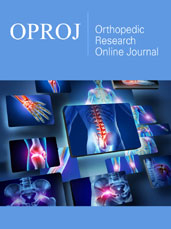- Submissions

Abstract
Orthopedic Research Online Journal
Day Hospital Facility, An Inpatient Alternative for Pediatric Spinal Cord Injury Care
-
Open or CloseJuan M Talavera-Mosquera1, Irene García Camacha2, Raúl M Martín2, Melchor Álvarez de Mon-Soto3 and Elisa López-Dolado4*
1Staff Physiatrist, Rehabilitation Department, Hospital Nacional de Parapléjicos of Toledo, Spain
2Tenured Professor, Department of Mathematics, Toledo School, Universidad de Castilla-La Mancha, Spain
3Head of Internal Medicine Department, Hospital Universitario Príncipe de Asturias de Alcalá de Henares, Spain
4Chief Clinician of the Rehabilitation Department, Hospital Nacional de Parapléjicos de Toledo, Spain
*Corresponding author: Elisa López-Dolado, Pediatric Spinal Cord Injury Unit, Hospital Nacional de Parapléjicos of Toledo, Associate Professor, Department of Medicine and Medical Specialties, School of Medicine, Universidad de Alcalá de Henares, Spain
Submission: May 13, 2022Published: May 23, 2022

ISSN : 2576-8875Volume9 Issue4
Abstract
Study design: Observational retrospective study.
Background: The present work was aimed to determine if the founding of a day patient facility (DPT) was able to optimize inpatient (IP) effectiveness measures and if there were differences in the patient’s clinical profile depending on the modality of care. Setting: Pediatric Unit of the Hospital Nacional de Parapléjicos of Toledo (Spain).
Methods:All the children attended, both IP and outpatient, were analyzed throughout two different years: 2006, the year immediately prior to the start-up of the DPT facility, and 2015, ten years after its foundation. A descriptive and inferential statistical analysis was performed for the study purpose.
Results: In 2006, there were different 75 inpatient children treated. From the 156 patients attended in 2015, 16.7% reported receiving IP regime, 61.5% DPT regime, and 21.8% in combined modality (CM). The average age of DPT was significantly lower than IP (P<0.01). Almost half of IPs processes exhibited AIS A SCI in both years (46.7% in 2006, and 46.2% in 2015), while a 67.7% of DPT patients showed AIS C or D in 2015. With respect of the hospitalization activity monitoring, we found that the presence of a DPT involved an increase in the IP average length of stay (from 20.83 to 39.78 days) and bed occupancy (from 27.72% to 42.04%) with a decrease in the bed turnover (from 4.86 to 3.86).
Conclusion:A DPT facility is able to improve the healthcare of pediatric SCI children by optimizing the use of IP resources.
 a Creative Commons Attribution 4.0 International License. Based on a work at www.crimsonpublishers.com.
Best viewed in
a Creative Commons Attribution 4.0 International License. Based on a work at www.crimsonpublishers.com.
Best viewed in 







.jpg)






























 Editorial Board Registrations
Editorial Board Registrations Submit your Article
Submit your Article Refer a Friend
Refer a Friend Advertise With Us
Advertise With Us
.jpg)






.jpg)














.bmp)
.jpg)
.png)
.jpg)










.jpg)






.png)

.png)



.png)






